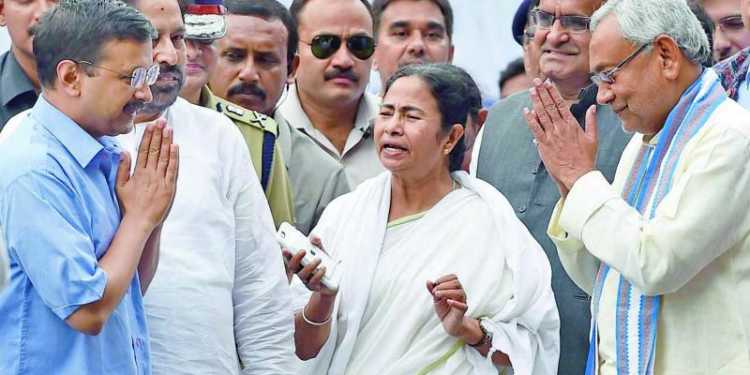Ever since Mamata Banerjee got rid of the Communist dispensation in Bengal, she has moved from strength to strength. Since the 2014 Lok Sabha elections, she controls the fourth largest contingent of MPs in the lower house. Earlier this year, her state of West Bengal handed her a resounding victory in the assembly elections. Her tally increased from that of 2011, which itself was considered a major sweep. Her party has made steady inroads into the Northeast as well, as a depleting Congress Party leaves behind a large political vacuum.
Last week, the Election Commission bestowed upon Trinamool Congress the status of ‘National Party’. This is currently held only by six other political outfits in India, with the requirement being representation in at least four state assemblies. Parties belonging to this category are allotted government land to set up offices, and airtime on the national broadcaster during election season. But for Mamata, these privileges are just the tip of the iceberg.
Mamata Banerjee has officially broken into the big league. Judging by several parameters, she is by far the strongest regional leader in India today.
Unlike Nitish Kumar, her government isn’t propped up by another regional strongman. Unlike Chandrababu Naidu and Chandrashekhar Rao, she is under no compulsion to keep the union government amused. Unlike Jayalalithaa, she has emerged stronger from her last election and has no resurgent opposition to deal with. Unlike Naveen Patnaik, she is consciously in the limelight and making forays into unexplored territory, indicating her ambitions are not limited to her own state. Unlike the Yadavs of U.P., neither is her party in disarray nor does the threat of growing anti-incumbency loom large. And very much like Arvind Kejriwal, she has carved out a cult personality for herself. The support she enjoys on the ground is unwavering.
Whether it is charges of corruption and violence, whether it is sting operations and CBI investigations, nothing affects Mamata Banerjee.
For the BJP though, this might be a blessing in disguise. Mamata’s popularity forced the BJP to forgo the state of West Bengal. But with a resurgent Mamata, the anti-Modi brigade is now rudderless. With too many aspirants to lead this potential front, it is likely that they will end up breaking into two, three or four fronts. Firstly, despite being in steady decline, none of the parties which seek to lead this front enjoy the pan-India presence of the Congress Party.
If this alliance compromises of the Congress Party, there is no reason for it to allow any other outfit to be in the driver’s seat. Moreover, because of its pan-India presence, it would be contesting the highest number of seats anyway. Jayalalithaa would most likely opt out of such an arrangement. She has no qualms about her prime ministerial ambitions, and will refrain from being part of an alliance that forces her to play second fiddle.
The other two names which often make the rounds when this potential front is spoken of, are those of Nitish Kumar and Arvind Kejriwal. The latter’s government in Delhi is encountering failure after failure on a daily basis. It also seems increasingly that the confidence exuded by the party in Punjab and Goa will turn out to be a damp squib.
When Kejriwal is finally cut to size and exposed for being the media sensation he is as opposed to a leader with pan-Indian appeal, he will effectively be knocked out of the race to lead this front. Nitish Kumar on the other hand had plans to merge his party with several regional outfits and create a North Indian behemoth. He had plans to walk across the length and breadth of the country with the mantra of prohibition, and walk straight into Race Course Road come 2019.
Barely two months ago, he seemed to have everything figured out. He planned to generate so much support for himself that the Congress would be left with no option but to support him if they intended to overthrow Narendra Modi. But now, the regional outfits have backed out from such a merger. His prohibition policy in Bihar has backfired. And if certain media reports are to be believed, his alliance partner Lalu Prasad Yadav is planning to overthrow Nitish and instate his son in Nitish’s place.
What the mainstream media conveniently forgets when they project Rahul Gandhi, Arvind Kejriwal or Nitish Kumar as the leaders of this potential alliance, is that such an alliance will go nowhere without Mamata Banerjee. A crucial non-BJP state like West Bengal with forty-two Lok Sabha seats on offer, will have to play a key role if the entire anti-Modi brigade were to unite. In the current circumstances, there would be no logical reason for Mamata to play second fiddle.
If she is able to convert the initial inroads into a consolidated voter base in the northeast, her tally in 2019 might be even bigger than the Congress’. The Congress might have supported Nitish Kumar or Arvind Kejriwal out of strategic necessity, but is unlikely to do the same to Mamata Banerjee. Their dealings with the JD(U) and the AAP have been easy, while Mamata has refused to compromise with them.
But getting back to reality, the very idea of an anti-Modi brigade coming together, forming a front and taking on the BJP is laughable. Mamata’s meteoric rise has simply dampened the prospect further. There are too many centres of power. There is too little of compromise and strategic thinking. Each one is building castles in the air, oblivious of the fact that their ambitions are isolating themselves from the pack.
Mamata Banerjee’s rise will mean that the others will step up their respective games, and this will isolate them further. They will reign supreme in their smaller enclaves, while Narendra Modi and Amit Shah look on.


































